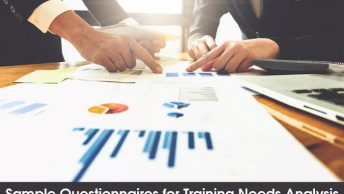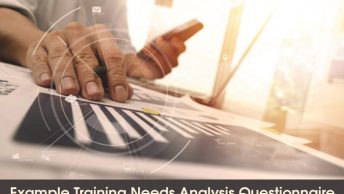A training needs analysis is a series of activities conducted to identify problems or other issues in the workplace. It determines whether – and what – training is an appropriate response.
The needs analysis is usually the first step taken in a process of change. Usually, there is a gap between the current and the desired individual and organizational performance. A needs analysis specifically defines that gap, and how much of it can be addressed with training.
Corporate training is a huge market. In 2022, it was valued at over $145 billion. It’s also rapidly expanding, set to grow nearly 10% every year. By 2028, it’s expected to exceed $250 billion in value. The last decade – and throughout the pandemic especially – has seen a major shift towards virtual training, but in-person training is just as important.
Not all of that training is really necessary – or well-executed. Inefficient training is a major waste of business resources.
The biggest cause of this waste is a lack accurate data on what an employee or group of employees actually needs to improve performance. A good Training Needs Analysis (TNA) can give you this data.
Investing in a deep analysis pays off, because it reduces resources wasted on ineffective training. Well-chosen training ups performance in the long run – and, finally, keeps high achievers in your company.
Who Conducts a Training Needs Analysis, and Why?
Both an in-house trainer or a consultant can perform a needs analysis to collect and document information. They’ll look for data on any of the following three issues:
- Performance problems
- Anticipated introduction of new system, task, or technology
- A desire by the organization to benefit from a perceived opportunity
In all three situations, the starting point is a desire to effect a certain change. Given this, you must know how the people who will experience the change perceive it. In the absence of a needs analysis and proper communication, you may find employees and even managers resistant to change and reluctant to training.
Training is also wasted when organizational constraints prevent trainees from transferring their newly acquired skills to their day-to-day jobs.
A needs analysis often reveals the need for well-targeted training areas. It will also reveal where training is not the best way to close a particular gap between an organization’s goals and its actual performance.
Those conducting the needs analysis must get a clear idea of the problem first. Then, they’ll look at all possible remedies and report their findings to management. Finally, there’ll be a decision on the best solution.
How Organizations Can Benefit
When done properly, a training needs analysis is a wise investment for the organization. It saves time, money, and effort by working on the right problems.
Organizations that dispense with needs analysis are much more likely to make costly mistakes. They mighty use training when another remedy would have been more effective. Use too much or too little training. They might train the wrong people – as when there is not a skill issue, but a management issue. Or they may use training but fail to follow up on it.
A well-performed analysis provides the information needed to find solutions that adress the areas of greatest need.
Conducting a training needs analysis is a systematic process. It uses specific information-gathering techniques. A needs analysis has stages, with the findings of one stage affecting and helping to shape the next one. There is no easy formula or short-cut for carrying out this process. Each particular situation requires its own mix of observing, probing, analysis, and deduction.
In many ways, the needs analysis is like detective work. You follow up on every lead and check every piece of information. You’ll examine every alternative before drawing any solid conclusions. Only then you can be sure of having the evidence on which to base a sound strategy for problem solving.
A training needs analysis is not a one-time event. Professional organizations run a needs analysis at regular intervals, usually every year or two.
Why Training Sometimes Fails
The majority of companies have developed training schemes for new hires and veteran employees. Their quality varies, of course. But that aside, these companies do have the advantage over those that don’t – and these aren’t few. About 40% of businesses lack formal training programs, and 32% don’t even have formal instruction to develop employees’ and new hires’ skills.
The root cause is this: Training is seen as a costly expense with an uncertain return. That means that results will vary. Moreover, they are difficult to quantify in the first place. Organizations naturally tend to minimize this type of expense, trying to cut costs by cutting corners. They’re unwilling to use resources for a proper Training Needs Analysis. After all, a proper one does take a lot of work and work-hours.
All too often, managers or HR departments will therefore simply recommend training for employees or groups of them. For this, they may rely on data from performance reviews. In practice, they often go with instinct, or just select what training they’re already familiar with.
Under these circumstances, the chance that the training actually adresses the underlying issues or needs are low. Performance often does not improve – and the organization’s initial assumption of uncertain return is then fulfilled. Training thus falls by the wayside.
With a proper training needs analysis, this process can be a lot more targeted, and companies can break out of the vicious circle of bad training. Whenever new hires or veteran employees receive new tasks, they can get up to speed quickly – rather than having to figure out everything on the job.
Risks of Skipping Training Needs Analyses
But there are more risks than wasting resources on inefficient and ineffective training. The problem doesn’t always just affect employee education. Leadership training, for instance, often fails because the existing system at an organization resists meaningful change.
In the long run, the business impact is severe.
Long-term mismatch between employee needs and training can result in top performers leaving companies for those that do offer good training. The cost of finding a replacement can be substantial. Such people will also avoid applying for a job at a company that neglects training in the first place.
Younger employees – Millennials and Gen Z – are especially focused on continued education. They make training a core factor for their choice of employer – preferring it even over higher salaries.
Ultimately, this drains your company of its best employees and makes it harder to hire new ones. This can do severe damage to your business operations, services, and finally your bottom line.
Methods of Identifying Training Needs
Training needs will differ with the backgrounds of the employees to be trained. It’ll also depend their present status in the organization. Basically, a candidate for training may come from any one of three groups:
1. New hires
2. Veteran employees
3. Trainees currently in the training pipeline (those currently in a training program)
These groups have varying needs. These form a frame of reference for discussing and suggesting methods for identifying training needs.
Training New Hires
Adding new employees creates peaks and lows in placing new persons into the training program. This problem may be solved by a program where hires progress through training in different sequences. This will eliminate the jams that will occur if all phases of the program must be taken in a fixed order.
The new employees will normally be of somewhat different backgrounds. Being new, they are not familiar with their new employers. As a result, the earliest phases of the training must concentrate on company orientation.
During these phases, the organization, organization policies and administrative details should be covered. It is also a suitable time to acquaint the trainees with what will be expected of them, and how they will be evaluated throughout the phase of training.
Retaining & Upgrading Veteran Employees
The people in this category offer a real challenge to the training department. Therefore, the number and amount of training required by this category should be carefully considered. Often the retraining and upgrading of long-time employees can be very rewarding for training instructors.
At least two schools of thought exist as to how these employees should be rekindled. There are advantages to keeping this group intact and tailoring a separate program to their needs. On the other hand, this category of employees can also make significant contribution to training if they are mingled with the new hires.
Supporting Employees in the Training Pipeline
A good training program will normally have participants in various phases of completion. Both training staff and an employee supervisor should be aware of completion dates. They’ll also need to know which tasks the employee will work on.
A trainee should have a challenge in all phases of his training. They should not be limited to those phases where the pipeline employee is sitting in a classroom. There will be periods between formal classes. During those times, employees should complete thorough interim test-work. For one, this work solidifies what they learned in the prior phase. For another, it serves as preparation for the coming phases.
Analysis Techniques for Determining Specific Training Needs
There are several methods you can use to gather data about employees’ performance. Each works well in different circumstances. Thus, you’ll need to determine which be the best for you. None of these methods can stand alone. Always use at least two, if for no other reason than to confirm your findings. One of those you choose should always be observation.
1. Observation
In this approach, an employee’s performance itself is you source of information. You evaluate a worker’s performance through first-hand observation and analysis. The most practicable way to do that is to watch the worker as a non-participating observer.
Put simply, you’ll look, listen, and then evaluate what you see and hear. What you won’t do is get involved in the employee’s work process in any way.
To make this activity more productive, create and use a checklist to remind you of what to look for and take notes. It can be very job-specific: This checklist example specifically concerns asbestos removal workers.
Your goal as an observer is to identify both strengths to build on and deficiencies to overcome. A key advantage of using direct observation in the needs analysis is that you gain first-hand knowledge. You’ll better understand the job performed. It also shows you the strengths and weaknesses of the indiviual worker.
2. Interviews
Interviews are crucial for conducting the needs analysis. To get the most out of them, create an interview guide ahead of time. The Society of Human Resource management has put together a template. The primary value of interview guides is that they ensure that you get the same kindof data from all sources.
This makes it much easier for you to find out whether a statement is one person’s opinion, or a widespread perception.
An interview guide encourages you to ask each worker a number of predetermined questions. Therefore, you must select questions that are essential to what you are trying to learn.
Interviews allow you to meet employees face to face to discuss their impressions of performance. Because you are in conversation with workers, you can explore their responses in more depth. You can ask or clarification of comments and for examples of what they mean. In this way, you obtain a full understanding of their performance deficiencies.
Well-executed employee interviews also have a few other, less obvious benefits for you:
- Ask intelligent questions and listen well to the answers. This builds your own credibility with your interviewees.
- You gain the employees’ personal involvement and commitment to your efforts.
- You establish personal relationships with potential trainees. These bonds are important to your success as a needs analyst and trainer.
3. Questionnaires
A questionnaire is a sort of interview on paper. You create your own questionnaire by writing down all the questions you want your employees to answer for you. Then you mail it to them and await their responses. It’s usually not a bad idea to also give them some incentive to answer it.
The key advantage of a questionnaire is that you can include every person from whom
you want input. Employees can complete the questionnaire when and where they choose. You need not travel and spend time with all respondents. Every employee responds to the same questions, and consequently data is very easy to compile and analyze.
TNA questionnaires can also be anonymous, which encourages honesty.
Questionnaires can be useful in obtaining a ‘big picture’ of employee’s impressions. At the same time, they allow everyone to feel that they had a chance to take part in the needs analysis process.
4. Job Descriptions
Before establishing a job description, carry out a job analysis. This involves a thorough study of all responsibilities of the relevant job. The scope is company-wide. The analysis should go into detail. Trainers should be able to use the job analysis as a yardstick for their course content.
A job analysis simplifies both writing the job description and the needs analysis. With an accurate description of an employee’s job, trainers can tailor his training curriculum. Training can then very closely approximate what will be expected of the employees.
5. Difficulty Analysis
A job analysis focuses on enumerating the numerous duties that a worker must perform. A difficulty analysis, on the other hand, determines which duties cause the employee the most trouble. It can then make suggestions on how to reduce this trouble through better training.
There are several key advantages to a good difficulty analysis. Here are just two of them:
- The needs analyst can give priority to certain aspects of the training. These priorities will depend on the expected difficulty that the worker will face in those duties.
- A good difficulty analysis provides example material. The training program can make use of role-playing material and situations.
6. Problem-Solving Conferences
This is another time-tested technique for gathering needs analysis material from employees. Problem-solving conferences can be conducted periodically. It may take the form of – or be part of – a plan for a new product, task or technology, or can tie in with a training program.
It is usually helpful to use an outside consultant to moderate such sessions. This outside sponsorship lets workers express their feelings about the organization more candidly. The current problems will become apparent that represent potential areas for training. This allows you to better gear the session to training needs.
7. Appraisal Reviews
The periodic counseling performance interview is another opportunity to gather data. Question employees on the duties and training of a worker. Comments during the appraisal interviews are usually genuine. They help establish the needs, variations, and penetrations to include in the training program.
Feedback at appraisal interview time is valuable since it is timely information. Appraisal sessions are also relevant because training needs differ from worker to worker. Together, the employee and supervisor or manager can uncover the cause of weaknesses in performance. These deficiencies represent areas for training.
8. Analysis of Employee Drive Patterns
The extent of an employee’s development depends on his motivations. It’s useful to identify the forces – the drives – that cause an employee to behave in certain ways. It can help determine their individual training needs. It’ll also give you ideas on how to stimulate their desire to fulfill that need.
An analysis of this kind may find out that the employee has an urgent need for more self-confidence. Their individual program can be tailored to suit that need. Regardless of the exact content, it should stress the importance of attitude, skills, and any other assets. These are all things that would give them this self-confidence.
9. Analysis of Organizational Policy
Organization policy will affect the amount of training offered. An explanation of various policies is something you should cover in the training program. Of particular concern are those policies that involve the training programs themselves. These might govern designing, changing, and major revisions of programs.
Sometimes, you need to show great sensitivity towards current policies and expected changes. These situations include merger activity, product diversification, or penetration of a new market.
Three Things to Keep in Mind During Training Needs Analysis
Whatever the method used to identify training needs, you have to keep least the following three points in view:
- Use these methods in combination. Never rely on just one method.
- You can identify the training needs of each of the various groups of employees.
- Ultimately, apply the analysis to the individual employee. Training need will vary from person to person.














thanks…
excellent.very informative. i am a language and soft skills trainer.i am always on the lookout to improve myself.
can you please send me samples of TNA questionnaire. i really need it. thank you
Can you pls send me a sample questionnaire for a TNA. Tnx
please send me a copy of the TNA questionarie. I really ineed urgently. Thankyou!
please send me the questionnaire for my TNA relating the issue of time management for study of our class fellows.
I am learning how to do the TNA. Can I have a sample output of a TNA?Thank you.
Can you pls send me a sample questionnaire for a TNA. Thanks
Can you pls send me a sample questionnaire for a TNA. Thanks
Hi!
Please send me sampleTNA Questionnaire, and report /template /format Thanx
Please send me a sample questionnaire for TNA. I need this urgently. Thanks
Kindly send a sample TNA questionnaire for reference. Thank you
Please send me a sample set of TNA questionaire related to automotive industry,thx
Hi! I am an HR Officer and we are currently re-organizing our training and development system. We would like to ask from your end if you could send us a copy of TNA that would help us in creating a similar tool. Thanks a lot.
Hi,
Can you please send me a questionaire for TNA ?
Thank you, love your website. very informative !
KB
Please send me a TNA questionnaire urgently
You are enhancing a lot of knowledge to us. Thanx very much.
can you please send me samples of TNA questionnaire. i really need it. thank you
Heyya,
M an MBA student and m developing a questionnaire project on training need analysis for a start up company could you please help me out ( sample size is jsd 20 to 22 people)
Ma mail id is [email protected]
Could I please have obtain a sample copy of the TNA questionaire? thanking you in advance.
Could you please send me a copy TNA questionaire? many thanks.
Very useful information presented in a clear and concise manner.
Can you please send me the questions or a sample questionnaire about TNA and i want to know more about the 360 feedback i believe that would help us in our company.
Good Morning. am working as a training coordinator and am conducting training need analysis for corporate. could you please send me sample of TNA. Thanking you in advance.
Thank you for a great article. It has given me an idea where to get started on TNA, just like the others, may I also ask for a sample of TNA for sales or for general company needs.
I have also found this webste very informative. I am new to training and am currently performing a training needs analysis. Could you please send me a sample of TNA related to sales and service please. Thanks in advance
send me a copy of the TNA concepts
Hi! Can you please send me a sample TNA questions? Thank you so much.
Hi
I have been requested to conduct a TNA for about fifty members of a local business association. The members of the business association are small scale business owners running their various businesses in town and the association would like to conduct a number of training programmes for its members that will mainly focus on business skills and knowledge development. The objective of the TNA is to identify the required trainings for the members.
The association would like to have theTNA conducted in one day, this is due to limited resources. What approaches and methods / techniques could be used to conduct such a TNA?
I would be grateful to receive your comments urgently.
Thank you
P Muteto
LIVINGSTONE ZAMBIA
Interesting article and obviously much needed. I am surprised by the number of HR people who have been left in charge of possibly the most valuable part of a trainig plan the TNA without the training or tools to deliver. Keep up the good work
Charlotte Mannion Chartered Fellow CIPD
Good Morning. Great article! Could you please send me sample of TNA. Thanking you in advance.
Reply
This article is exactly what I’ve been looking for. Could you please send me a sample TNA as well.
Thanks!
can you please send me samples of TNA questionnaire. i really need it. thank you
Hi! Can you please send me a sample TNA questions? Thank you so much.
Please,send me some notes on:
(a) Training Policy Purposes.
(b) Ways of Discovering Training Needs.
(c) Tangible Benefits of Training Needs Analysis.
Hello Dear all:
I hope you all fine. i would like to request from you all. on Wednesday my interview has been schedul for the position of ( Training Officer). What kind of quesations will be aske in ther interview.
Sincerly Ahmad Jawad.
could you please send me a TNA questionnaire as well?
Thanks!!!!
will you please send me a copy of the TNA….My company is a brand new company and this would help us out .
Please can you send me a copy of TNA questionaire?
Thank you so much
Great aricle. Could you send me a TNA questionairre? If possible can you send one based on healthcare worker needs in the patient care setting?
I really enjoyed your article, I would like to hear more sometime as I have been reading your articles regularly.
I’ve recently started working as a training manager for medium sized retail company and they’ve never had formal training for employees and no HR manager either. Can you plz send me a TNA questionnaire? I want to convince the CEO of the importance of doing a TNA before anything else happens.
[…] As for a good and reasonable how to do a needs assessment, check out this link: http://www.dirjournal.com/guides/how-to-conduct-a-training-needs-analysis/ […]
Great article. Can you please send me a sample of the TNA questions? Many thanks.
Very informative article. Educative too… Look fwd to reading and learning more from you… God bless!
[…] By the way, if you are looking for a good, how-to on doing a basic needs assessment, here’s a good place (besides our Training Library) to start: http://www.dirjournal.com/guides/how-to-conduct-a-training-needs-analysis/ […]
hello, this is swamy, i need questionnair could you send pls thanks in advance.
Hi,
Apprecaite if you could send me a sample of TNA questionnaire for technical competency.
thanks a lot
Thanks for this information. I am a trainer and part of my jobs include training needs assessment. Could you please send me the TNA form and typical winning training proposal?
Thanks.
Assalaamu Alaikum
Excellent article Jazak Allah Khair. Is it possible to send me a TNA template
my email is [email protected]
Excellent article can you plz send me the TNA questionare
hi
Dear friend .
i just got job in the company . i have been requested to frame question on TNA for the employee. so pliz, could you send me. i will be graceful for your help.
thanks for the article it’s been of great help.
[…] For information on how to conduct a needs assessment, check out this link: http://www.dirjournal.com/guides/how-to-conduct-a-training-needs-analysis/ […]
it is indeed an honor to learn from this site
This article X-ray many parts of training needs. Am really pleased with the information gathered therein.
Thank you for sharing this
Can i please have a sample of the TNA Questionnaire. I am in charged of looking at improving this area and i just would like and idea of how the TNA Questionnaire looks like.
iI have been asked to submit a TNA for a farmer based organization in a local community. can you kindly send me a template to enable me submit a good TNA.
Very informative and I have learnt a lot. I am currently tasked to come up with a TNA for Corporate and Investment Banking, may you please kindly share.